Chapter 13 Transformations in Asia and Africa on the Eve of European Overseas Expansion
Section 3 Mughal
India to 1707
Despite its name, the
Mughal dynasty had little to do with the Mongols (Mughal is Persian for Mongol).
Essentially Turkish in origin and Persian in culture, the Mughals were the most
successful and brilliant of all Islamic dynasties in India. Indeed, it was one
of the greatest dynasties in Indian history, the equal of even the Mauryans
under Asoka. Like the Ottomans, the Mughals acquired a vast and ethnically
diverse empire and demonstrated considerable skill in uniting it and ruling it
effectively. They left a dazzling cultural legacy, especially in poetry and
architecture. Only after the death of Akbar in 1605 did poor leadership,
religious intolerance, and the intrusion of European powers begin to unravel
what the earlier Mughals had accomplished.
Rise of the Mughal
Dynasty
The long era of the Delhi Sultanate was brought to an end by one of the most colorful and fascinating figures in all of Islamic history, Zahir al-Din Muhammad, known as Babur (“the Tiger”). The life of this remarkable man can be followed in great detail since he took what was, for a Muslim ruler, the unusual task of writing his own biography.[8]
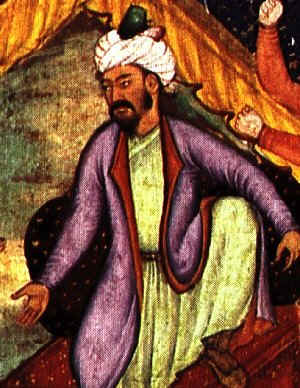
Zāhir ud-Dīn Muḥammad ibn ʿUmar Sheikh, known as Babur, 'the Tiger,' taken from http://www.kamat.com/kalranga/muslim/2349.htm
Babur was born in 1483, descended on his father’s side from Timur and on his mother’s from Chengiz Khan. Despite this impressive Mongol pedigree, Babur thought of himself as Turkish, spoke and wrote in Turkish, and regarded the term Mongol as an insult. As a young boy he inherited the territory of Farghana, but he dreamed of conquering an empire for himself in Central Asia. In the early 1500s he tried to take Samarqand. Not only was he defeated in these efforts by the Özbek Khan Shayban in 1501, he was also driven out of Farghana. After a few years of wandering, Babur and a small following of other fugitives managed to take the town of Kabul - but his hopes for a Central Asian empire continued to be frustrated by Shayban Khan.
Although he served the Safavid Shah Isma'il for a time, eventually Babur cast his ambitious gaze on India. In April 1526 he and his followers attacked the Delhi Sultan, Ibrahim Lodi, at the battle of Panipat. Babur's force reportedly numbered only 12,000 men - against Ibrahim Lodi’s army of 100,000 men and 100 war-elephants. Nevertheless, within only a few hours of battle being joined, Ibrahim Lodi was dead, 15-20,000 of his troops killed, and the rest of his army routed. Babur’s tactics were almost identical with those that the Ottomans had used at Chaldiran (he had an Ottoman advisor in his camp)—infantry and artillery protected behind a barricade of carts with cavalry on the flanks. Babur’s combination of gunpowder weapons and effective mounted archers had more than compensated for his fewer numbers. The following year he defeated an equally large Rajput army commanded by Rana Sanga of Mewar at the Battle of Khanwa.
These two battles won Babur a vast empire, but it was not the one he wanted and he does not seem to have liked it very much. In his autobiography, he noted that India had much gold and silver but complained that otherwise it did not compare with his homeland in Central Asia:
“Hindustan is a country that has few pleasures to recommend it. The people are not handsome. They have no idea of the charms of friendly society, of frankly mixing together, or of familiar intercourse. They have no genius, no comprehension of mind, no politeness of manner, no kindness or fellow-feeling, no ingenuity or mechanical invention in planning or executing their handicraft works, no skill or knowledge in design or architecture; they have no horses, no good flesh, no grapes or musk melons, no good fruits, no ice or cold water, no good food or bread in their bazaars, no baths or colleges, no candles, no torches, not a candlestick.”[9]
Fittingly, after Babur died in 1530, his body was moved
from the capital at Agra to where his heart had so often been, Kabul.
Babur established an empire that was primarily Turkish in origin,
Persian in culture, Muslim in faith, and Hindu in population.
© K.L. Kamat/Kamat's
Potpourri
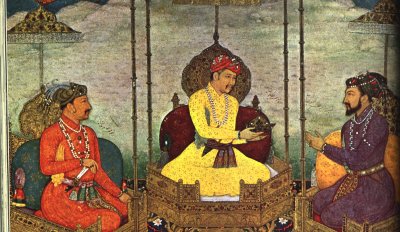
The mighty Mogul emperors (Left to Right) Jahangir, Akbar the
great, and Shah Jahan (who built the Taj Mahal)
Taken
from http://www.kamat.com/kalranga/mogul/2372.htm
Consolidation of the
Mughal Empire
After Babur, the man most responsible for firmly establishing Mughal rule was probably Akbar the Great, who ruled from 1556 to 1605. Akbar proved himself to be a sovereign of the highest quality. He greatly increased the size of his empire through a series of successful wars. To prevent revolts or insurrections, he was careful to maintain a monopoly of gunpowder weapons and to control all the major fortresses and fortified cities in the empire.
Akbar also refined and improved the framework of administration in order to centralize it and insure the authority of the ruler. As both the Ottomans and Safavids had done, he reasserted royal jurisdiction over crown lands. He also brought tax collection firmly under direct central government control. Where the Ottomans and Safavids had bolstered imperial power by creating slave institutions, Akbar implemented the mansabdar (“holders of command”) system – a hierarchical group of salaried imperial officials both military and civilian. The majority were foreigners, but about a third were Indian-born and included both Muslims and Hindus.
Akbar sought not just to use his non-Muslim subjects but actually to integrate the Hindu and Muslim elites in an egalitarian way. He himself married a Rajput princess and his chief minister and advisor was Raja Todar Mal, a Hindu. Akbar abolished the discriminatory poll-tax formerly imposed on non-Muslims. He used Rajputs as governors, generals, and high officials, and he allowed Rajput nobles to enjoy symbols of status similar to those used by Muslim notables.
Perhaps Akbar’s most interesting efforts to unify the diverse population of his empire can be seen in his religious policy. His Persian tutor, had reportedly taught the young Akbar that all religions have good qualities and seek to worship the same divinity—and should thus be respected and tolerated. Later, he also fell under the influence of the unconventional religious scholar Shaykh Mubarak and his sons, the poet Fayzi and the historian Abu’l-Fazl, who became his close friends. In 1575, Akbar established an institution known as the “House of Worship,” where he presided over religious discussions and debates among the ulama and eventually between the ulama and representatives of other religions, including Christianity. This probably served both to expose the weaknesses of the ulama and to assert Akbar’s authority over them. In 1579, he exercised the prerogative once held by caliphs to deliver the Friday sermon and coerced the leading ulama into signing a decree confirming that he was the “Shadow of God” and a religious authority who could supplement the shari’a with his own laws on the basis of the public good. Opposition to him would lead to punishment in this world and damnation in the hereafter. One of his first acts under this new dispensation was to take control of the endowments that provided the ulama with financial support. Conservative religious elements backed a revolt against Akbar from 1580-82, but it was suppressed and its leaders executed. The culmination of his religious policy was the promulgation in 1582 of a creed known as the Din-i Ilahi, or “Divine Faith.” It blended ideas and practices from many existing religions and was organized much like a Sufi order with Akbar as its spiritual guide. However, it won little support from either Muslims or Hindus.
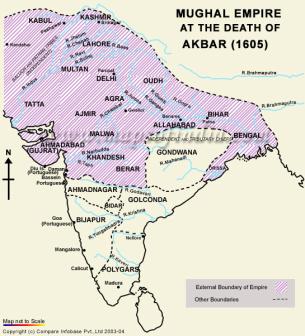
Taken
from http://www.india-history.com/medival-india/mughal-empire.html
The Mughal emperor Akbar tried to establish unity in the empire by
merging Hindu and Islamic traditions.
The Height of Mughal
Power
The last years of Akbar’s reign were marred by many tragedies, one of the most unfortunate being a conflict with his son Salim, better known as Jahangir. The quarrel may have been due to a dispute over Jahangir’s romance with a palace-maid, whom Akbar had killed. In 1591, Akbar accused Jahangir of trying to poison him, and in 1599, Jahangir instigated an inconclusive revolt against his father. A few years later, he had Akbar’s friend and adviser Abu’l-Fazl murdered.
Jahangir was ill-tempered, addicted to alcohol and drugs, and cared nothing about religion. Fortunately for the government of the empire, the incompetent Jahangir was eventually content to turn the management of affairs over to his wife, Nur Jahan Mihr al-Nisa. She was intelligent, charming, and could ride and shoot as well as any man (once killing four tigers in a row!) Nur Jahan minted coins with her name, signed imperial documents, helped the needy and orphans, and is credited with holding the empire together despite Jahangir’s neglect.
In the reign of Shah Jahan (1627-58), Nur Jahan was banished from court but the new emperor was deeply devoted to Mumtaz Mahal, her niece, who became his wife. When Mumtaz Mahal died in 1631, Shah Jahan was desolate and never remarried. She was buried in Agra, where Shah Jahan built over her tomb one of the most beautiful monuments in the world, the famous Taj Mahal.
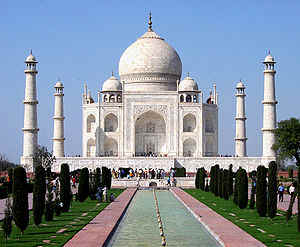
Taj Mahal, mausoleum of Mumtaz Mahal, beloved wife of Shah Jahan, taken from http://en.wikipedia.org/wiki/Taj_Mahal
Shah Jahan was a much more vigorous but not necessarily a better ruler than Jahangir. He put down rebellions and constructed new fortresses. He destroyed the Portuguese settlement at Hugli, and conquered new territories in the Deccan area of southern India. In the northwest he briefly recovered Qandahar from the Persians, and attempted unsuccessfully to annex the old Mughal homeland in Central Asia. Paying for all this military activity, however, strained Mughal resources, and the populace suffered from heavy taxation and outbreaks of famine.
Probably to gain the support of the ulama, Shah Jahan also began backing away from the tolerant religious policies of earlier Mughal rulers. He destroyed some Hindu temples and Christian churches and restricted marriages between Hindus and Muslims. When he fell ill in 1657, his sons began fighting to succeed him. The victor was Awrangzib, a veteran soldier and staunch Sunni who had dealt ruthlessly with the Shi’as of the Deccan. In 1658, Awrangzib imprisoned his father Shah Jahan in the Agra fortress and usurped the throne.
Awrangzib completely reversed Akbar’s policies. He courted the favor of the ulama and insisted on strict observance of the shari’a. He expelled Hindus from government service and restored the poll tax and Islamic inscriptions on the coinage. He even tore down many Hindu temples and built mosques in their place. His reign was one of almost constant wars and revolts. Nevertheless, he enlarged the empire. He also adhered scrupulously and puritanically to Islamic morals in his personal life, compiled a digest of Islamic law, and promoted Islamic scholarship. Consequently, Muslims have generally regarded him as one of the greatest rulers of India.
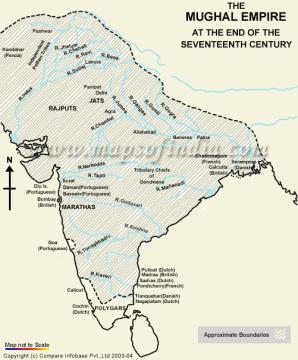
Taken from http://www.india-history.com/medival-india/mughal-empire-in17th.html
Under Shah Jahan and Awrangzib, the Mughal Empire reached its height.
Aspects of Mughal
Culture
Not surprisingly, given its history, Mughal culture represented a blend of many different influences. In its origins it was Turkish—Babur wrote his memoirs in Chagatay Turkish—but it became heavily Persianized. Both Babur and his successors had direct contacts with Safavid Persia, and many officials attracted to India by the generous salaries offered by the Mughals came from Persia. In 1582, Akbar made Persian the official administrative language of his empire.
Literature. In the field of literature, poetry was greatly valued by the Mughal rulers and scores of Persian poets came to India seeking fame and fortune. The Persian and Indian born poets gradually developed a distinctive style of poetry known as sabk-i Hindi—very formal, innovative in vocabulary and technique, philosophical and moralistic in content. Historical writing also flourished under the Mughals. Aside from Babur’s memoirs, Abu’l-Fazl’s biography of Akbar, the Akbar-nameh is an important example of Mughal historiography. Akbar also encouraged the translation of Indian works such as the Mahabharata, Ramayana, and Upanishads into Persian.
Architecture. Like the Ottomans and Safavids, the Mughals were great builders, and their richest cultural legacy is their art and architecture. The Taj Mahal, probably the best known and most admired of the Mughal buildings, is but one of their impressive monuments. They blended Indian, Persian, Central Asian, and other styles in their buildings. The great fort at Agra, the fortress-palace of Lahore, the gardens of Shalimar, and the colossal mosques such as those at Delhi and Lahore are all excellent examples of Mughal architectural skill.
Aside from the Taj Mahal, however, the best introduction to Mughal art and architecture is probably the city of Fathpur-Sikri. Akbar had it constructed near the shrine of the Sufi saint Salim Chishti who had foretold the birth of Akbar’s son. Later abandoned because of its inadequate water supply, it is an open-air museum of Mughal architecture. Its huge congregational mosque and exquisite monumental gateway, the Buland Darvazeh, are ranked among the best of the Mughal creations.
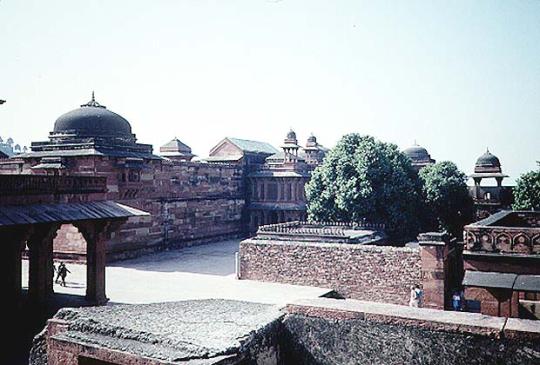
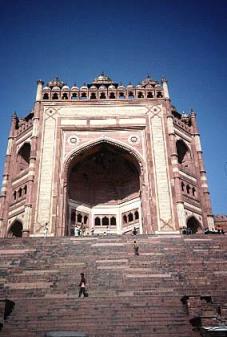
Left: View of Fatehpur Sikri
from the "Panch Mahal," the tallest tower in the palace complex. In
the foreground is the "Akbar palace." In the distance (center) is the
great mosque, the Jami Masjid, which served as a model for later congregational
mosques built by the Mughals. Right: The Buland Gate, entrance
into the courtyard around the Jami Masjid.
Copyright, Deborah Haynes, PhD; for educational and non-commercial use only.